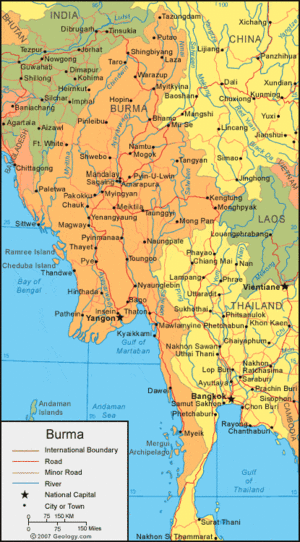Haripunjaya
| Author:Laxman Burdak, IFS (R) |
Haripunjaya (हरिपुंजय) or Hariphunchai was an ancient Mon kingdom centred in the Mae Nam (river) Ping Valley in northwestern Thailand. It was founded in the mid-7th century by a queen of Lopburi, the capital of the Mon Dvaravati kingdom to the south. Although originally established as a colony of Dvaravati, Haripunjaya maintained its independence and its own ruling dynasties as a member of a loose confederation including the Mon states of Dvaravati and Thaton.[1]
Contents
Variants
- Haripunjaya (हरिपुंजय) (AS, p.1009)
- Haribhunjaya (हरिपभुंजय) (Thai: หริภุญชัย)
- Haribhuñjaya (हरिपभुंजय) (Pali)
- Hariphunchai
History
Haripunjaya flourished and developed an advanced civilization. Espousing the conservative Theravāda Buddhism, the kingdom acted as a transmitter of Indian cultural influences. The development of irrigation systems, law, and art forms were among its accomplishments. Haripunjaya was barely able to maintain its independence against attacks by the Thai in the 9th century and the Khmer (Cambodians) in the 10th century. It also conducted continual warfare against Dvaravati, which was conquered by the Khmer in the early 11th century.[2]
Hariphunchai was a Mon kingdom in the northern Siam of present Thailand in the centuries before the Thais moved into the area. Its capital was at Lamphun, which at the time was also called Hariphunchai.[3] In 1292 the city was besieged and captured by Mangrai of the Thai kingdom of Lan Na.[4]
According to the Camadevivamsa and "Jinakalamali" chronicles, the city was founded by a hermit named Suthep in 629 AD, and the Mon ruler of Lavo Kingdom (present-day Lopburi) sent his daughter Jamadevi to become its first queen. At that time, most of what is now central Thailand was under the rule of various Mon city states, known collectively as the Dvaravati kingdom. Queen Jamadevi gave birth to twins, the older succeeding her as the ruler of Lamphun, and the younger becoming ruler of neighboring Lampang.
Flourishing and downfall
After centuries of independence, the advanced civilization of Haripunjaya was absorbed by the Thai when the Thai ruler Mangrai conquered Haripunjaya in 1292, establishing the city of Chiengmai a few miles from Lamphun, the old capital of Haripunjaya. The Mon became the teachers of the Thai and influenced the development of Thai writing, scholarship, and art forms.[5]
The kingdom under King Adityaraja, came into conflict with the Khmers in the twelfth century. Lamphun inscriptions from 1213, 1218, and 1219, mention King Sabbadhisiddhi endowing Buddhist monuments.[6]
The chronicles say that the Khmer unsuccessfully besieged Hariphunchai several times during the 11th century. It is not clear if the chronicles describe actual or legendary events, but the other Dvaravati Mon kingdoms did in fact fall to the Khmers at this time. The early 13th century was a golden time for Hariphunchai, as the chronicles talk only about religious activities or constructing buildings, not about wars. Nevertheless, Hariphunchai was besieged in 1292 by the Lan Na king Mangrai, who incorporated it into his Lan Na ("One Million Rice Fields") kingdom.
List of rulers
Names of monarchs of the Hariphunchai kingdom according to Tamnan Hariphunchai (History of Kingdom of Hariphunchai):
- Camadevi (चामदेवी): Queen of Lavanapura (=Mathura)
- Hanayos
- Kumanjaraj
- Rudantra
- Sonamanjusaka
- Samsara
- Padumaraj
- Kusadeva
- Nokaraj
- Dasaraj
- Gutta
- Sera
- Yuvaraj
- Brahmtarayo
- Muksa
- Traphaka
- Uchitajakraphad king of Lavo
- Kampol
- Jakaphadiraj, King of Atikuyaburi
- Vasudev
- Yeyyala
- Maharaj, King of Lampang
- Sela
- Kanjana
- Chilanka
- Phunthula
- Ditta
- Chettharaj
- Jeyakaraj
- Phatijjaraj
- Thamikaraj
- Ratharaj
- Saphasith
- Chettharaj
- Jeyakaraj
- Datvanyaraj
- Ganga
- Siribun
- Uthen
- Phanton
- Atana
- Havam
- Trangal
- Yotta
- Yip
हरिपुंजय
हरिपुंजय (AS, p.1009): हरिपुंजय उत्तरी स्याम (थाईलैंड) में स्थित प्राचीन भारतीय राज्य है जिसका वृतांत स्याम की पाली इतिहास कथाओं-चामदेवीवंश तथा जिनकालमालिनी (15वीं-16वीं शती ई.) में मिलता है। इनसे ज्ञात होता है कि हरिपुंजय की स्थापना [p.1010]: 661 ई. में ऋषि वासुदेव ने की थी। दो वर्ष पश्चात् इनका निमंत्रण पाकर चामदेवी, जो लवणपुरी की राजकुमारी थी, यहां आयी थी। इसके साथ अनेक बौद्ध भिक्षु भी आये थे। जिन्होंने हरिपुंजय में बौद्ध धर्म का प्रचार किया।[7]
External links
References
- ↑ https://www.britannica.com/place/Haripunjaya
- ↑ https://www.britannica.com/place/Haripunjaya
- ↑ Coedès, George (1968). Walter F. Vella (ed.). The Indianized States of Southeast Asia. trans.Susan Brown Cowing. University of Hawaii Press. ISBN 978-0-8248-0368-1.p.77
- ↑ Coedès, George (1968). Walter F. Vella (ed.). The Indianized States of Southeast Asia. trans.Susan Brown Cowing. University of Hawaii Press. ISBN 978-0-8248-0368-1., p.208
- ↑ https://www.britannica.com/place/Haripunjaya
- ↑ Coedès, George (1968). Walter F. Vella (ed.). The Indianized States of Southeast Asia. trans.Susan Brown Cowing. University of Hawaii Press. ISBN 978-0-8248-0368-1., p.195
- ↑ Aitihasik Sthanavali by Vijayendra Kumar Mathur, p.1009-1010
